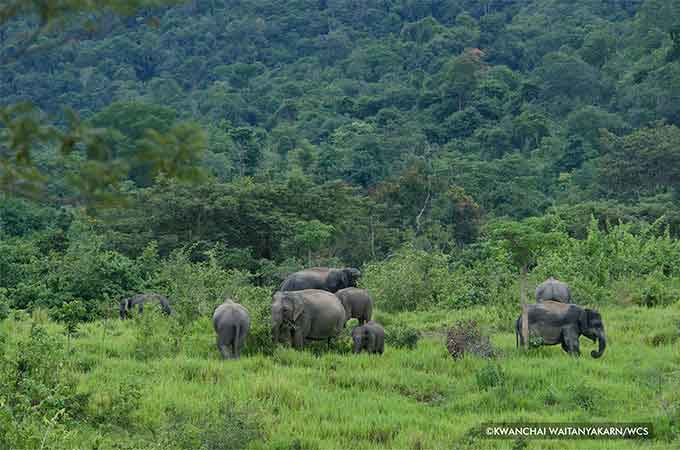Status, Habitat, and its roles in the Ecosystem
Asian Elephants (Elephas maximus) are the largest land mammals in the world. The shoulder height of an adult Asian elephant is around 2.5 meters with 3 - 4 tons in weight. Asian elephants are social animals. They live in herds. A new generation male will leave his herd when he is 6 - 7 years old, and will ready to mate at 10 - 15 years old. During this period, the young male elephant will be in rut. The female will be ready for reproduction at the age of 15 - 16 years old with the gestation period is 22 months, the longest of any land animal, and give birth to a single cub. The interval for each litter is 4 years. Elephant cub mortality can be due to hunting by natural predators and infanticide (killed by males from other herds). However, adult elephants have very low rate of mortality. They can live up to 60 or 70 years.
Asian Elephants can be found in Nepal, Bangladesh, India, Sri Lanka, Myanmar, Thailand, Laos, Cambodia, Malaysia, and Sumatra. From the latest comprehensive assessment reports there are approximately 41,410 - 52,345 of survival Asian Elephants throughout Asia (IUCN Red List, 2009). Found in several places in Thailand, there is around 2,500 - 3,200 elephants remaining (IUCN Red List, 2009). The number has been decreasing each year with forest reduction, fragmentation, and threats such as hunting and other human activities. The dilation of communities around the protected areas gives the direct impact to their population. The Human and Elephant Conflict (HEC) is now a crucial issue that requires collaboration in effective mitigation methods because such problems tend to get worse and that may affect another 20 protected sites throughout the country in the near future.

Asian Elephants were categorized as one of the protected animals under Wildlife Preservation and Protection Act, and an endangered species (IUCN, 2008) as proclaimed in CITES Appendix I.
Asian Elephants survive in several conditions, from open grassland to deep evergreen forests. The size of home ranges and feeding vegetable types are varied, depending on gender, age, site conditions, and seasons. In India, female elephants require 184 - 326 km2 for their home range, while males require 188 - 407 km2. Asian elephants spend most of their time (about 14 - 19 hours per day) eating. They can eat 150 - 200 kg of food each day. They defecate an average of 16-18 times per day, and they can produce over 100 kg of dung. The elephant's dung is important to the ecosystem, not only as soil fertilizer but also for the dispersal of plant seeds. Given the distance of elephants’ large home ranges, plant species can be dispersed far away. Especially for large seeded species that only large animals can consume will benefit from being dispersed far away by elephants. Moreover, elephants dung provides home and food for several species of insects. In Khao Ang Rue Nai Wildlife Sanctuary, it is found that elephants dung feeds at least 29 families of insects. And, these insects take part in keeping balance in the ecosystem.
Therefore, elephants can be considered as an umbrella species and a flagship species in our conservation effort since efforts to protect the elephant will cause other species under its umbrella to also be preserved.
Interesting Resources:
Verdant Planet: http://www.verdantplanet.org
Wikipedia: https://en.wikipedia.org/wiki/Asian_elephant
Relevant Projects & Activities